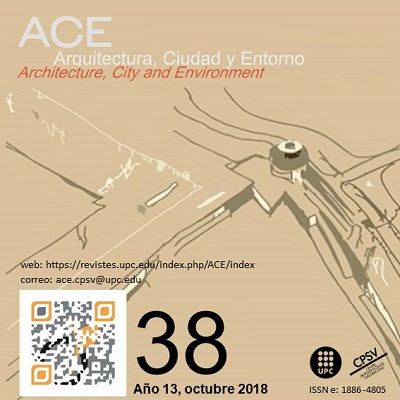La noció de sòl: una definició de Permeabilitat Urbana a Hong Kong i Barcelona
DOI:
https://doi.org/10.5821/ace.13.38.5432Paraules clau:
Espai públic, urbanitat, porositat urbana, passeigs de vianants, espai col·lectiuResum
Objectiu
El famós pla de Roma de Nolli (1748) il·lustra la permeabilitat de l'estructura urbana de la ciutat utilitzant una representació de planta i per primera vegada incloent els patis i les àrees internes dels edificis públics com a espais cívics. Aquest article es refereix a la qüestió d'identificar i descriure la noció de permeabilitat urbana mitjançant l'anàlisi de dues ciutats paradigmàtiques, Barcelona i Hong Kong.
Metodologia
En aquest article s'analitzarà la relació simbiòtica entre l'arquitectura i la ciutat, els espais públics urbans i l'entorn construït mitjançant una anàlisi comparativa. Amb l'objectiu d'aclarir la noció de permeabilitat urbana en diferents contextos espacials, s'analitzaran diversos fenòmens urbans per entendre els contrastos, similituds i especificitats d'ambdues ciutats.
Conclusions
Al centre històric de Barcelona, la intricada seqüència de places i passatges estratègics són un exemple extraordinari de permeabilitat urbana a nivell del sòl. D'altra banda, el districte financer de l'illa Central de Hong Kong demostra com circulen els fluxos de vianants com un fluid dens a través d'una xarxa tridimensional d'edificis, passos subterranis i passos de cel. Aquest sistema genera una sèrie d'espais col·lectius a diferents nivells i crea una circulació vertical que connecta directament amb el sistema de transport públic.
Originalitat
El grau de permeabilitat urbana influeix en l'exploració i la percepció de l'entorn urbà. No obstant això, no hi ha estudis específics sobre com aquesta qualitat caracteritza l'estructura espacial de Hong Kong i Barcelona. Aquest article abordarà aquesta bretxa del coneixement mitjançant l'anàlisi d'aquestes dues formes urbanes denses i complexes.
Descàrregues
Publicades
Número
Secció
Llicència
| CRITERIS DE PROTECCIÓ INTEL·LECTUAL |
En aquest moment es compta amb la protecció de la Oficina Espanyola de Patents i Marques, mentre que la protecció global s'està tramitant davant la Organització Mundial de la Propietat Intel·lectual (OMPI/WIPO). Així mateix, la Oficina del Número de Sèrie Estàndar Internacional (ISSN) ha otorgat els següents números: 1886-4805 (versió electrònica) i 1887-7052 (versió en paper). |
| COPYRIGHT |
El contingut dels articles i els comentaris en ells expresats són responsabilitat exclusiva dels seus actors, i no reflexen necessariament la opinió del Comité Editor de la revista. Els treballs publicats per ACE queden sotmesos a la llicència CC BY-NC-ND 3.0 ES http://creativecommons.org/licenses/by-nc-nd/3.0/es/ La qual cosa vol dir que les persones autores només tenen i retenen els drets d'autor dintre de les limitacions imposades per la anterior llicència |





































